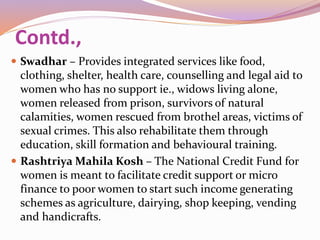Women abuse
- 1. PRESENTED BY: Mrs. DEVA PON PUSHPAM.I, ASSISTANT PROFESSOR.
- 2. INTRODUCTION Violence against women is partly a result of gender relations that assumes men to be superior to women. Manifestations of violence include physical aggression, such as blows of varying intensity, burns, attempted hanging, sexual abuse and rape, psychological violence through insults, humiliation, blackmail, economic or emotional threats, etc. Usually domestic aggression towards women and girls, due to various reasons remain hidden.
- 3. DEFINITION Any act of gender based violence that results in or is likely to result in physical, sexual or psychological harm or suffering to a woman, whether occurring in public or private life. - United Nations Women abuse is the intentional and systematic use of tactics to establish and maintain power and control over the thoughts, beliefs and conduct of a woman through the inducement of fear and / or dependency. - Reynolds and Schweitzer, 1998
- 4. TYPES OF WOMEN ABUSE Physical violence Sexual violence Emotional violence Psychological violence Spiritual violence Cultural violence Verbal abuse Financial abuse Neglect
- 5. Contd., Physical violence: It includes using physical force which results in pain, discomfort or injury, hitting, pinching, hair pulling, arm twisting, strangling, burning, stabbing, etc. Sexual violence: It includes touching in a sexual manner without consent, forces sexual intercourse, forcing a person to perform sexual acts, beating sexual parts of the body, etc. Emotional violence: It occurs when someone says or does something to make a person feel stupid or worthless. It includes name calling, blaming all relationship problems, not allowing to contact family or friends, etc.
- 6. Psychological violence: It includes threatening to harm the person, his/her family if he/she leaves, threatening to harm oneself, threats of violence and abandonment, etc. Spiritual violence: It includes not allowing the person to follow his/her preferred spiritual or religious tradition, forcing a spiritual or religious path or practice on another person, belittling or making fun of a person’s spiritual or religious tradition, etc. Cultural violence: It includes committing crimes against women ie., physically harmed, shunned, maimed, or killed for falling in love with wrong person, seeking divorce, being raped, etc. Contd.,
- 7. Verbal abuse: It includes recalling a person’s past mistakes, threatening violence, lying, yelling, insulting, swearing, talking unkindly about death, etc. Financial abuse: It includes not allowing the person to participate in the educational programmes, forcing the person to work outside home, refusing to work outside home, refusing to attend school, misusing funds, etc. Neglect: It includes abandonment in public setting, not remaining with a women who needs help, disregarding necessities of daily living, failing to provide necessities, ignoring special dietary requirements, etc. Contd.,
- 8. PREVENTIVE MEASURES Enforcement of laws on violence against women. Supporting gender sensitization by conducting public awareness programs. Encourage the media to play s constructive role. Provision of easily accessible 24*7 information services to inform any violence related to women. Provision of legal services free of cost or at affordable cost. Regional women related policies. Strengthening mahila mandals and women’s organization all over India. Education to all women. Family support. Women help lines – 1090 / 1091
- 9. Women welfare programs in India: Beti Bachao Beti Padhao – Respecting, protecting and fulfilling the rights of girls and women to stop gender based violence. Swayamsidha – Integrated scheme for the development and empowerment of women through self help groups. Swashakti Project – Increase women’s access to resources to better quality of life. This is achieved through health education and training on income generating schemes. ICDS – Services including immunization, health check up, nutrition and health education and refreshment services to children and pregnant women.
- 10. Contd., Training and employment program for women – Provides new skills and knowledge to women who do not have any income or property. They are trained in areas like agriculture, animal husbandry, dairying, fisheries, handloom, handicrafts, etc. Swavlamban – Provides training and skills to women to enable them to obtain employment or become self employed ie., computer programming, medical transcription, electronic assembling, radio and TV repairs, garment making, weaving, embroidery, etc. Hostels for working women – Provides financial assistance for construction and expansion of hostel buildings for working women to provide safe and affordable accommodation to working women including girls pursuing professional courses.
- 11. Swadhar – Provides integrated services like food, clothing, shelter, health care, counselling and legal aid to women who has no support ie., widows living alone, women released from prison, survivors of natural calamities, women rescued from brothel areas, victims of sexual crimes. This also rehabilitate them through education, skill formation and behavioural training. Rashtriya Mahila Kosh – The National Credit Fund for women is meant to facilitate credit support or micro finance to poor women to start such income generating schemes as agriculture, dairying, shop keeping, vending and handicrafts. Contd.,
- 12. Laws relating to violence against women: Crimes under IPC : Rape, kidnapping and abduction, dowry deaths, torture both mentally and physically, molestation, sexual harassment, etc. Gender Specific Laws : Pre-conception and Prenatal Diagnostic Techniques Act, 1994 Medical Termination of Pregnancy Act, 1971 Dowry Prohibition Act, 1961 Protection of women from domestic violence act, 2005













